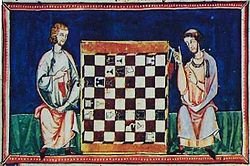
Welcome, friends – settle in. Today I want to take you on a journey that begins with a single, jewel-like image and expands into one of the most surprising, important stories in European history. That image is a medieval miniature from the Libro de los juegos, the Book of Games, commissioned by King Alfonso X of Castile and completed in the 13th century. At first glance it’s simply a scene of two men bent over a chessboard inside an Arab-style tent. But look closer and the picture becomes a doorway: to the tangled, creative, often uncomfortable encounters between Christians and Muslims that helped build the Europe we think we know.
Why should a tiny painted scene matter to us now? Because in an age of quick judgments about migration, identity, and the supposed “clash” between Islam and the West, that miniature invites a different story – one of exchange, adaptation and mutual influence. The Europe that emerged through the Middle Ages was scarcely an isolated Christian monolith. It was hybrid, a product of conflict and collaboration, and in many ways shaped by ideas, techniques, and people who came through the Islamic world.
Over the next few thousand words I want to unpack that single image and the vast history it opens. We’ll trace chess from its origins in India to Islamic Spain and medieval Europe; we’ll decode the visual language of the miniature and the intellectual climate that produced the Libro de los juegos; and we’ll examine how science, architecture, literature, and everyday life in Europe were transformed by contacts with the Islamic world. Most of all, we’ll consider what this history can teach us today about coexistence, exchange, and identity.
A Painted Moment of Calm in a Violent Century
Picture the miniature. Two men lean over a chessboard. They sit inside a pointed, Arab-style tent. Outside, spears stand in the sand, a pennant flutters, and one of the players has a sword slung casually across his body. The palette shimmers in indigo, vermilion, and ochre; the figures are rendered with care and quiet humanity. One player wears a turban; the other is dressed in European clothing. Neither looks hostile. Neither brandishes a weapon. Both are absorbed by the game.
This is a scene painted in late 13th-century Castile, in the milieu of King Alfonso X – “the Wise.” The image appears in a book that is, in itself, a statement about cultural mixture. Alfonso’s Libro de los juegos (finished in 1283, work on it having started earlier in the 1250s) gathered knowledge about games from across Mediterranean and Islamic worlds. The book’s chess section is the earliest extended European treatise on chess, and it includes not only rules and problems but translations and interpretations of material derived from Arabic authors.
In the lifeworld of medieval Spain, this image would not have seemed strange. War and negotiated peace were part of life. The Reconquista – the long, complex process by which Christian kingdoms in the Iberian Peninsula expanded at the expense of Muslim-ruled territories – was punctuated by truces, alliances, intermarriages, and everyday interactions. The court of Alfonso X in Toledo was, by his choice, literally a place of translation and collaboration: Christian, Jewish, and Muslim scholars worked together on scientific, legal and literary projects. In that context, an image of two men from opposite religious backgrounds playing chess together becomes a visual shorthand for a lived reality of exchange.
Chess: From Chaturanga to Shatranj to Europe
To appreciate the miniature fully, we need to follow the pawn’s path back to the game’s origins. Chess did not spring from Europe. Its earliest ancestors are traced to northern India in the late antique period, where a game called chaturanga – literally “four divisions” of the military: infantry, cavalry, chariots and elephants – simulated battlefield tactics. Pieces represented different arms of warfare; the board stood for a battlefield. From India the game spread into Persia, where it became known as shatranj. Persian courts refined rules and traditions, and poets and storytellers embedded the game in culture and lore.
When Arab armies conquered Persia in the 7th century, they adopted the game and helped spread it through the Islamic world. Islamic scholars and courts not only played chess; they wrote about it, debated strategies, and produced diagrams and problems. The game served as intellectual exercise and as a metaphor for political power and military strategy.
From the Islamic world, chess travelled into Europe via Spain and Sicily, regions where Muslim rule was established for centuries and where cross-cultural exchange was intense. By the 10th and 11th centuries, chess was played at Christian courts as well as Muslim ones. Over time the pieces themselves were reinterpreted: in the Islamic context an elephant piece existed (from the Persian pil); in Christian Europe that piece evolved into a bishop, reflecting local institutions and symbolism. Centuries later, other rule changes – such as the increased powers of the queen – would further transform the game into the modern variant we recognise.
That a single board game should act as a conveyor of cultural meaning is not accidental. Games travel easily because they are practical, teachable, and portable. You can demonstrate a rule once and have someone playing in minutes. In medieval Europe, chess became a site where ideas of kingship, hierarchy, and strategy were debated and embodied. But its path to European courts shows clearly that key pieces in Europe’s intellectual and cultural toolbox travelled through the Islamic world, where knowledge was collected, refined, and transmitted.
The Libro de los juegos: A Monument of Translation
Alfonso X’s Book of Games sits at the heart of this story. Officially produced in Alfonso’s scriptorium, the work reflects his unusual priorities. Alfonso was not merely a king; he was a scholar-king who sponsored translations of Arabic and Hebrew works into Castilian and Latin. Under his patronage, Toledo became a magnet for translators and a conduit through which Byzantine, Arabic, and Jewish texts reached the rest of Europe.
The Libro de los juegos collects games of all kinds – dice, backgammon, and numerous chess variants. It is notable for relying heavily on Arabic sources. Alfonso’s translators were not all of one faith: Christians, Jews, and Muslims contributed. Their collaboration was not merely pragmatic; it was in some ways ideological. Alfonso believed that wisdom could be gathered from many traditions. The book’s lavish illuminations – tiny scenes like our chess players – are not decorative afterthoughts; they are visual arguments. They assert that leisure, strategy, and study are universal practices, capable of bringing people together across cultural and religious divides.
It’s worth stressing the practical dimensions of these translation efforts. For centuries, much of Greek philosophy, medicine, and science existed in Arabic translations and commentaries. Without the translators of Toledo and other centres, Europe’s medieval universities and later Renaissance thinkers would not have had direct access to many of these ideas. The path was rarely direct; Greek texts were translated into Syriac, then Arabic; Arabic commentary flourished; later Latin translators produced the versions read in Paris and Bologna. But the net effect was clear: the medieval Islamic world preserved and expanded ancient knowledge and then passed it on to Europe.
Reading the Miniature as a Visual Argument
Let’s return to the painting and read it closely. The tent’s peaked fabric and decorative motifs evoke the aesthetic vocabulary of Al-Andalus and the broader Islamic architectural heritage. Yet it is painted in a Castilian manuscript; the artist is likely Christian but influenced by Islamic patterns – an example of Mudéjar sensibility in miniature form. The weapons outside the tent – spears planted in the sand – signal martial readiness; the sword across the shoulder speaks of a life that knows combat. But both are idle. The players’ attention is elsewhere. The board creates a level dynamic. It is a space in which social distinctions (for a moment) are suspended.
This suspension is significant. In a society organised around hierarchy and faith identity, the game becomes an equaliser. The king, the warrior, the scholar, each can be measured and judged by skill over a board rather than by birth or banner. That equality resonates with Alfonso’s intellectual project: to catalogue knowledge from many sources and to judge it on its merits.
Artists of the period were not writing manifestos, but manuscripts like this one nonetheless express attitudes about coexistence. Scholars have used the term convivencia to describe the relative tolerance and practical coexistence among Muslims, Christians, and Jews in parts of medieval Iberia. Convivencia was never utopian: it was often fragile, contested, and marked by inequality and periodic violence. But it also produced dynamic cultural exchanges, shared architectural styles, musical forms, and literary themes. The chess miniature is one small but potent artefact of that complex mix.
Beyond the Board: Islamic Contributions to European Civilisation
If the miniature is a starting point, the larger landscape of medieval exchange is vast. Muslim scholars preserved, critiqued, and augmented Greek philosophy and science. Figures such as al-Khwarizmi (whose name gave us “algorithm” and “algebra”), Ibn Sina (Avicenna), and al-Razi (Rhazes) developed medical, mathematical, and philosophical works that later became central texts for European universities. Medical knowledge from the Islamic world was taught in medieval European medical schools for centuries.
In architecture and art, the influence is visible too. The geometric patterns, calligraphic ornamentation, and interlacing designs of Islamic art found new expressions in Mudéjar architecture in Spain and influenced European decorative tastes more broadly. The Alhambra in Granada, with its intricate tilework and play of light and geometry, is one of the most famous examples, but smaller forms of influence – gardens, irrigation techniques, and urban planning, also had long-term impacts.
Trade and technology were vectors of change as well. Paper-making technology, transmitted from China via the Islamic world, revolutionised European book production; improved irrigation and crop techniques brought agricultural gains to parts of Iberia and beyond. New foods, spices, and culinary techniques flowed along these channels too. Linguistically, many everyday words in Romance languages derive from Arabic roots: algebr(a), alcohol, zero (via Arabic sifr), coffee, sugar, and numerous agricultural and legal terms all trace partial lineage through Arabic.
Sicily and the Norman courts offer another instructive example. In the 11th and 12th centuries the Normans ruled Sicily, a polity that combined Byzantine, Arab, and Latin elements. Norman rulers often used Arabic administrators, commissioned maps from Arab geographers (like al-Idrisi), and presided over a multicultural court. That model showed Europe could, at times, harness multiple traditions for political and intellectual advantage.
The Crucible Metaphor: Conflict and Alloy
A convenient metaphor for this process is the crucible: a vessel in which metals are melted and alloyed under high heat. The medieval contact zone was indeed a crucible. Wars and sieges generated terrible suffering, but the heat of conflict also produced cultural alloy. New blends of law, science, art, and commerce emerged from the pressures of contact. To think of Europe as a pure, static entity disrespects the messy processes by which it was formed.
This does not romanticise the past. The Reconquista culminated in brutal measures: forced conversions, expulsions, and the 1492 Alhambra Decree that expelled Jews from Castile and Aragon. Many Muslims and Jews suffered greatly as the medieval period progressed. Yet even in this painful and punitive context, the flow of knowledge and influence did not stop. Scholars moved, translated, and adapted. Texts found new homes in Italian city-states and in the libraries of northern Europe, feeding the intellectual ferment that led to the European Renaissance.
Challenging the “Clash” Narrative
Modern political rhetoric often frames relations between Islam and the West as anachronistically inevitable conflict. Samuel Huntington’s thesis about a post–Cold War “clash of civilisations” captured popular attention in the 1990s. But medieval Iberia complicates that binary. It shows a long history of entanglement, hostile and amiable, violent and cooperative, that produced hybrid institutions and ideas.
The chess miniature offers a corrective to deterministic thinking: identities are not neatly enclosed containers; they are porous, influenced by exchange. Medieval Europe was not built in isolation from the Islamic world. In many fields, from mathematics and medicine to architecture and poetry, European progress was indebted to innovations transmitted through Islamic lands.
Living Legacies: The Past in the Present
You don’t need to be a historian to see continuities from medieval exchanges to our present moment. Today’s Europe includes millions of Muslim citizens whose contributions shape culture, technology, sports, and politics. Modern debates about migration, integration, and identity echo medieval challenges – how to live together, how to respect difference while building common institutions.
There are immediate lessons in that history. One is intellectual humility: much of what we take for granted in Western civilisation came through layers of mediation, translation, and borrowing. Recognising that helps deflate claims of pure originality and suggests a more pluralistic narrative of cultural achievement. Another lesson is practical: social and intellectual flourishing often comes from exchange, not isolation. The producers of the Libro de los juegos understood this intuitively; Alfonso’s court made translation and comparative study a policy.
I’ve had the chance to see echoes of this lived history in person. Walking through Toledo can feel like stepping through history’s strata: churches built on mosques, synagogues adapted into Christian spaces yet retaining Hebrew inscriptions, markets where Spanish, Arabic, and Ladino once mixed. These are not merely tourist curiosities; they are physical records of centuries of contact.
What the Chessboard Can Teach Us Now
So what does this one miniature tell us that is relevant in 21st-century democracies? Several concrete takeaways:
• Complexity over simplicity. Human histories are seldom reducible to single narratives of conflict. They are messy, full of cooperation and competition. Policies and journalism that ignore that complexity produce brittle thinking.
• Institutions matter. Alfonso’s deliberate patronage of translation and scholarship created long-term intellectual returns. Modern policymakers who invest in cross-cultural education, language learning, and academic exchange can foster similarly durable benefits.
• Everyday practices shape culture. Games, food, markets, and crafts often travel more easily than formal doctrine. Focusing on shared everyday life – sports clubs, neighbourhood associations, cultural festivals – can build trust in ways formal politics cannot.
• Preservation and translation matter. The medieval translators did the labour of preservation and mediation that later generations relied on. Today’s libraries, universities, and cultural institutions play the same role: preserving, contextualising, and making knowledge accessible across communities.
• Rejecting determinism. The idea that civilizations inevitably “clash” removes agency. It naturalizes conflict instead of framing peaceful coexistence as a set of choices and policies we can cultivate.
Checkmate, but Not the End
In the miniature, the two players are absorbed, the game unfinished. The board is a stage where strategic thinking happens; it is also an arena of encounter. That unresolved image is a useful emblem for the story of Europe and the Islamic world: ongoing, incomplete, and full of potential.
History does not absolve injustice. The medieval period includes horrific episodes – expulsions, inquisitions, forced conversions – that should not be glossed over. But if we focus only on those, we miss another essential fact: across centuries of violence, exchange persisted. Knowledge, craft, cuisine, and art crossed borders. People borrowed and adapted. Political leaders sometimes embraced coexistence for pragmatic ends; other times they sought purification. Both tendencies are part of the record.
The Book of Games and its tiny chess scene do something valuable: they force us to recall an older story of connection. They remind us that Europe was formed not as a single, sealed tradition, but as an alloy forged in a crucible of encounters, suffering, and astonishing acts of creative borrowing.
Your Move
What resonates with you about this story? Have you seen historical traces of coexistence in your own city? Do you play a game that brings people together across difference? I’d love to hear your thoughts and stories. If you enjoyed this dive into a single image that opens so many doors, share it with a friend who loves history, chess, or stories about how cultures meet.
If there’s appetite, next I’ll show images from the Libro de los juegos and walk through other illuminations that reveal similar cross-cultural dynamics. For now, I’ll leave you with the image of the two men at the chessboard – enemies, perhaps, in one register; companions in another; and in both, unmistakably human.


